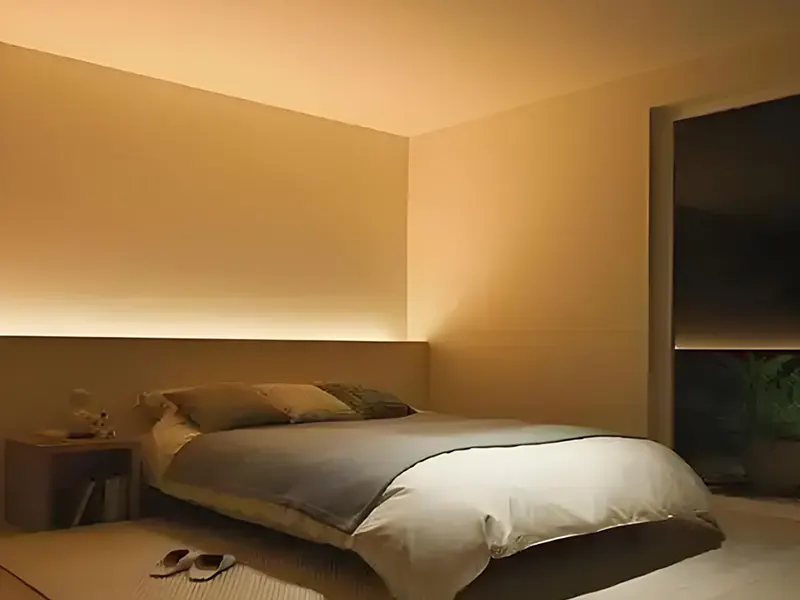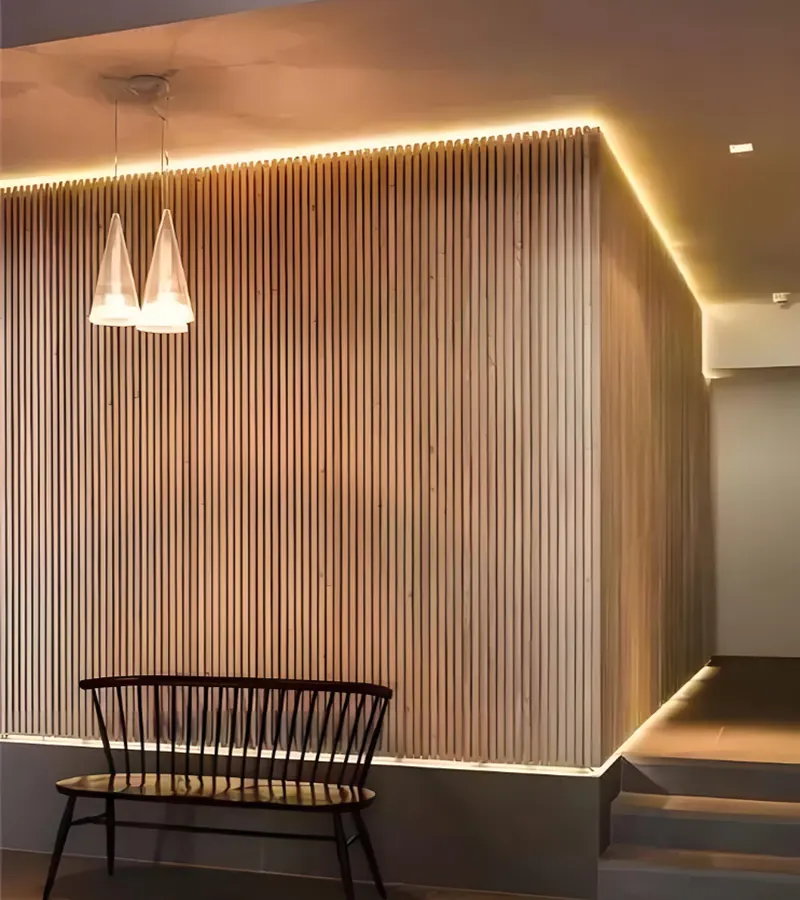
In modern lighting design, we often hear the terms “indirect lighting” and “direct lighting.” So what does indirect light really meaning? Compared to traditional direct lighting, indirect light offers a softer, more comfortable visual experience. Therefore, it’s increasingly used in home decor, commercial spaces, and high-end venues.
However, many people aren’t clear about the difference between indirect and direct lighting, or even know how to determine which type of lighting they’re using. This article will delve into the meaning, characteristics, advantages and disadvantages of indirect light, and suitable application scenarios, helping you make informed and informed lighting choices.
What is the Meaning of Indirect Light?
Indirect lighting refers to light sources that don’t shine directly on objects. Instead, they first strike the ceiling, walls, or other reflective surfaces, where they are refracted or scattered into the space. This reduces the intensity of the light and creates a softer, more even illumination.
Indirect lighting design
- Living room ceiling LED strips: These strips are hidden in the ceiling’s recesses. The light first strikes the ceiling and then reflects downward, creating a warm and inviting atmosphere without glare.
- TV background wall: Add a soft light strip behind the TV to reduce direct sunlight and minimize eye strain while watching TV.
What is Direct Lighting?
Direct lighting refers to direct illumination of a light source directly onto a target or space, without any secondary reflections. Its advantages include high luminous efficiency and energy efficiency, making it suitable for applications requiring high brightness.
Direct lighting design
- Desk lamps: The light source shines directly onto books, providing high illumination. This is beneficial for students reading and writing.
- Supermarket shelf spotlights: The light shines directly onto the merchandise, creating a brighter surface and attracting customers’ attention.
- Jewelry cabinet LED strips: The light shines directly onto the jewelry, making it appear shiny and eye-catching.
What’s the Difference Between Direct and Indirect Light?
If we observe the lighting in our homes, we’ll find that modern lighting is divided into direct and indirect light. They’re often used interchangeably, creating a harmonious effect.

Summary of Direct and Indirect Light
Direct Light:
- 1: The light source is usually visible, directly illuminating objects or spaces. It’s bright, casts sharp shadows, and can be glaring.
- 2: Direct light is generally used in offices, classrooms, and store displays; these areas are illuminated by direct light.
Indirect Light:
- 1: The light source is hidden or invisible, reflecting/refracting before entering the space.
- 2: Soft, even light creates a pleasant atmosphere, but with relatively low brightness. It’s primarily used in bedrooms, living rooms, hotel lobbies, and restaurants.
Lighting Design Tips
In homes or commercial spaces, you don’t have to choose between the two; instead, use a combination:
- Living Room → Main Light (Direct Light) + Ceiling Strip Light (Indirect Light)
- Bedroom → Bedside Strip Light (Indirect Light) + Desk Lamp (Direct Light)
Are LED Lights Considered Indirect or Direct Lighting?
LEDs are essentially light sources; they don’t categorize them as direct or indirect lighting. The nature of the light is determined by its installation method and where it’s emitted. Let’s briefly explain the differences between the two methods of using LED lights.
- LED downlights (direct lighting) → direct lighting
- LED strips hidden in ceiling troughs → indirect lighting
What Kind of Indoor Light is Considered Indirect?
Let’s briefly analyze indirect light sources indoors. The following lighting examples are commonly seen.
- Ceiling LED strips: Used in living rooms and bedrooms, they reflect and evenly distribute light.
- Wall washers: Illuminate the wall and then reflect it into the space, highlighting the wall’s texture.
- Under-cabinet lights: Reflect light onto the countertop, minimizing glare and adding a sense of depth.
- Stairway light strips: Illuminate the staircase and serve as a safety guide.
- Bedside background lights: Minimize eye irritation from direct overhead light, promoting sleep.
How Can you Directly Determine Whether Light is Direct or Indirect?
Some people still have trouble identifying direct and indirect light at first glance, so remember the following tips to help you easily identify the two.
Can you see the light source? If you can, it’s direct light; if you can’t, it’s indirect light.
Are shadows clear? If there are distinct shadows, it’s direct light; if there are almost no shadows, it’s indirect light.
Light distribution: If there’s strong local brightness, it’s direct light; if the overall brightness is even and soft, it’s indirect light.
What are the Disadvantages of Indirect Lighting?
We’ve learned about the advantages of indirect lighting. So, what about its disadvantages?

Luminous Efficiency Loss
Indirect lighting relies on reflection. For example, when a light strip hits the ceiling or wall, it’s reflected back into the room. This process results in a loss of light efficiency, typically 20–40% lower than direct light. Therefore, even if the light strip itself has excellent specifications, illumination may be insufficient if the reflective surface is dark gray or wood veneer.
High Installation Cost
Indirect lighting often requires designing ceilings, light troughs, and baseboard recesses. This not only increases the construction process but also requires a higher level of design precision. For example, a living room might require recessed light strips embedded in the ceiling. This requires coordination between carpentry, painting, and installation, increasing costs and time.
Inconvenient Maintenance
Because the light fixtures are hidden in the ceiling or wall, damage requires dismantling the ceiling or cutting grooves, making repair much more complex than surface-mounted fixtures. This is especially true for recessed COB light strips. If the driver fails, replacing it often requires damaging the ceiling.
Inadequate lighting
Indirect lighting is generally used for ambient lighting and often fails to meet basic illumination requirements. For example, in a 30-square-meter living room, if light strips are placed only around the perimeter of the ceiling, the brightness in the center area will often fall below 100 lux, creating dead spots.
How to Determine If Indirect Light is Bright?
For small rooms, indirect light can be used as the primary lighting source. For larger rooms, it’s recommended to combine it with downlights and wall lamps. You can also use the following methods to determine the brightness.
- Check the wattage of the light strip: 12W/m COB light strips are a common standard. For larger rooms, consider 15W/m.
- reflective surface: White latex paint has a reflectivity of 70–80%, while light gray or wood finishes may only have a reflectivity of 40–50%. The lighter the surface color, the brighter the indirect light.
- Check the size of the space: For a small bedroom (around 10 square meters), a single 12W/m light strip is sufficient; however, a large living room (30–40 square meters) may lack sufficient lighting and may require additional pendant lights or downlights.
- Test with a lux meter: The common standard for living spaces is 100–300 lux; kitchens and study rooms require 300–500 lux. If the light level is below 100 lux, the lighting is insufficient.
When is Indirect Lighting Best for Indoor Lighting?
Indoor lighting options vary depending on the function of the room. Here are some places to install indirect lighting:
Bedroom
Indirect light is ideal for bedrooms, creating a sense of relaxation. For example, a hidden light strip behind the bed, replacing a bedside lamp, not only creates a nice ambiance but also avoids direct glare.
Living Room
It’s an excellent ambient light source. For example, installing warm white light strips around the ceiling creates a sense of depth, and then using spotlights to illuminate the sofa or coffee table creates a beautiful and practical effect.
Dining Room
Indirect light can make food look more appealing. For example, installing a hidden light strip in the ceiling above the dining table and pairing it with a uniquely designed chandelier creates a soft, inviting atmosphere.
Hotel/Commercial Space
Indirect light can enhance the style. For example, hotel lobbies often use light strips to outline the space, creating a high-end atmosphere. Mall corridors use light strips as guide lines, creating both aesthetics and a sense of direction.
Cinemas/Audio-visual Rooms
Indirect light is almost standard. Light strips in the corners of the walls or on the ceiling provide a faint background light to avoid complete darkness and reduce eye fatigue.
Summary
Indirect light meaning a crucial aspect of modern lighting. It creates a soft, comfortable, and comfortable light environment. Compared to direct light, it’s more suitable for creating atmosphere and a sense of spatial depth. However, due to its limited brightness, it often needs to be used in conjunction with direct light. It’s important to understand these two aspects before choosing the lighting method that’s right for your needs.
FAQs
Indirect lighting refers to light that doesn’t directly strike a space, an object, or your eyes. Instead, it bounces off other surfaces (such as walls, ceilings, or floors) and is then dispersed throughout the room.
The key difference lies in how the light reaches our eyes—meaning how we perceive it. Direct light occurs when the light source shines directly into the room. Indirect light occurs when the light reflects off surfaces and enters the room.
No, LED lights themselves are the source of light. Whether they are direct or indirect depends on how they are installed. If you install an LED light strip directly under a cabinet, shining it onto a countertop, that’s direct light. If you hide the same light strip in a ceiling recess, shining it upward and reflecting it off the ceiling, that’s indirect light.
Common examples of indirect light in a room include LED light strips hidden in a ceiling recess that shine upward. We have light strips that we install behind the TV, mirror or headboard. There are also lamps that are hidden near the floor or ceiling and cast light on the wall.
